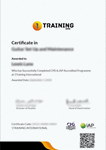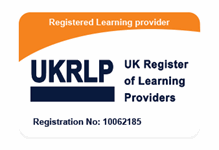Machine Learning : Quant Trading
ACCREDITED BY CPD & IAP | Free Digital Certificate Included | Unlimited Access 365 Days | Quality e-learning Materials
1 Training
Summary
- Exam(s) / assessment(s) not included in price, and must be purchased separately
- TOTUM card available but not included in price What's this?
Overview
Machine Learning Quant Trading
During this excellent Machine Learning – Quant Trading learners will focus on practically applying ML techniques to develop sophisticated Quant Trading models. This Quant Trading course will give you an introduction to machine learning, a subject which gives computers the ability to learn without being programmed. For those interested in Quant Trading, this course teaches you to apply machine learning to Quant Trading. Discover how to build sophisticated financial models that will better inform your investing decisions.
Our learning material is available to students 24/7 anywhere in the world, so it’s extremely convenient. These intensive online courses are open to everyone, as long as you have an interest in the topic! We provide world-class learning led by IAP, so you can be assured that the material is high quality, accurate and up-to-date.
What skills will I gain?
- Develop Quant Trading models using advanced Machine Learning techniques
- Compare and evaluate strategies using Sharpe Ratios
- Use techniques like Random Forests and K-Nearest Neighbours to develop Quant Trading models
- Use Gradient Boosted trees and tune them for high performance
- Use techniques like Feature engineering, parameter tuning and avoiding overfitting
- Build an end-to-end application from data collection and preparation to model selection
CPD
Course media
Description
What skills am I going to get from this course?
- Develop Quant Trading models using advanced Machine Learning techniques
- Compare and evaluate strategies using Sharpe Ratios
- Use techniques like Random Forests and K-Nearest Neighbours to develop Quant Trading models
- Use Gradient Boosted trees and tune them for high performance
- Use techniques like Feature engineering, parameter tuning and avoiding overfitting
- Build an end-to-end application from data collection and preparation to model selection
COURSE CURRICULUM
Module 01 : You, This Course & Us
- Introduction – You, This Course & Us!
Module 02 : Developing Trading Strategies in Excel
- Are markets efficient or inefficient?
- Momentum Investing
- Mean Reversion
- Evaluating Trading Strategies – Risk & Return
- Evaluating Trading Strategies – The Sharpe Ratio
- The 2 Step process – Modeling & Backtesting
- Developing a Trading Strategy in Excel
Module 03 : Setting up your Development Environment
- Installing Anaconda for Python
- Installing Pycharm – a Python IDE
- MySQL Introduced & Installed (Mac OS X)
- MySQL Server Configuration & MySQL Workbench (Mac OS X)
- MySQL Installation (Windows)
- [For Linux/Mac OS Shell Newbies] Path & other Environment Variables
Module 04 : Setting up a Price Database
- Programmatically Downloading Historical Price Data
- Code Along – Downloading Price data from Yahoo Finance
- Code Along – Downloading a URL in Python
- Code Along – Downloading Price data from the NSE
- Code Along – Unzip & process the downloaded files
- Manually download data for 10 years
- Code Along – Download Historical Data for 10 years
- Inserting the Downloaded files into a Database
- Code Along – Bulk loading downloaded files into MySQL tables
- Data Preparation
- Code Along – Data Preparation
- Adjusting for Corporate Actions
- Code Along – Adjusting for Corporate Actions 1
- Code Along – Adjusting for Corporate Actions 2
- Code Along – Inserting Index prices into MySQL
- Code Along – Constructing a Calendar Features table in MySQL
Module 05 : Decision Trees, Ensemble Learning & Random Forests
- Planting the seed – What are Decision Trees?
- Growing the Tree – Decision Tree Learning
- Branching out – Information Gain
- Decision Tree Algorithms
- Overfitting – The Bane of Machine Learning
- Overfitting Continued
- Cross-Validation
- Regularization
- The Wisdom Of Crowds – Ensemble Learning
- Ensemble Learning continued – Bagging, Boosting & Stacking
- Random Forests – Much more than trees
Module 06 : A Trading Strategy as Machine Learning Classification
- Defining the problem – Machine Learning Classification
Module 07 : Feature Engineering
- Know the basics – A Pandas tutorial
- Code Along – Fetching Data from MySQL
- Code Along – Constructing some simple features
- Code Along – Constructing a Momentum Feature
- Code Along – Constructing a Jump Feature
- Code Along – Assigning Labels
- Code Along – Putting it all together
- Code Along – Include support features from other tickers
Module 08 : Engineering a Complex Feature – A Categorical Variable with Past Trends
- Engineering a Categorical Variable
- Code Along – Engineering a Categorical Variable
Module 09 : Building a Machine Learning Classifier in Python
- Introducing Scikit-Learn
- Introducing RandomForestClassifier
- Training & Testing a Machine Learning Classifier
- Compare Results from different Strategies
- Using Class probabilities for predictions
Module 10 : Nearest Neighbors Classifier
- A Nearest Neighbors Classifier
- Code Along – A nearest neighbors Classifier
Module 11 : Gradient Boosted Trees
- What are Gradient Boosted Trees?
- Introducing XGBoost – A Python library for GBT
- Code Along – Parameter Tuning for Gradient Boosted Classifiers
Module 12 : Introduction to Quant Trading
- Financial Markets – Who are the players?
- What is a Stock Market Index?
- The Mechanics of Trading – Long Vs Short positions
- Futures Contracts
Course Duration
Learners will have 365 days access to their chosen course. The course is self-paced so you decide how fast or slow the training goes. If you need to extend your course access duration, it can be done at any time by extending your subscription.
Method of Assessment
- You will have one assignment. Pass mark is 65%.
- You will only need to pay £19 for assessment.
- You will receive the results within 72 hours of submittal, and will be sent a certificate in 7-14 days.
Certification
Those who successfully pass this course will be awarded a Machine Learning – Quant Trading Certificate. Anyone eligible for certification will receive both FREE e-certificate (PDF format), and printed certificate.
Meet the Instructor
Janani Ravi, Vitthal Srinivasan, Swetha Kolalapudi, and Navdeep Singh have honed their tech expertise at Google and Flipkart. Together, they have created dozens of training courses and are excited to be sharing their content with eager students. The team believes it has distilled the instruction of complicated tech concepts into enjoyable, practical, and engaging courses.
- Janani: 7 years at Google (New York, Singapore); Studied at Stanford; also worked at Flipkart and Microsoft
- Vitthal: Also Google (Singapore) and studied at Stanford; Flipkart, Credit Suisse and INSEAD too
- Swetha: Early Flipkart employee, IIM Ahmedabad and IIT Madras alum
- Navdeep: Longtime Flipkart employee too, and IIT Guwahati alum
Who is this course for?
- Quant traders who have not used Machine learning techniques before to develop trading strategies
- Analytics professionals, modellers, big data professionals who want to get hands-on experience with Machine Learning
- Anyone who is interested in Machine Learning and wants to learn through a practical, project-based approach
Requirements
This course requires no formal prerequisites and this certification is open to everyone
Career path
- Quantitative Developer
- Software Developer
- Python Developer
- Quant Strategist
- Quant Analyst
Questions and answers
Currently there are no Q&As for this course. Be the first to ask a question.
Reviews
Currently there are no reviews for this course. Be the first to leave a review.
Legal information
This course is advertised on reed.co.uk by the Course Provider, whose terms and conditions apply. Purchases are made directly from the Course Provider, and as such, content and materials are supplied by the Course Provider directly. Reed is acting as agent and not reseller in relation to this course. Reed's only responsibility is to facilitate your payment for the course. It is your responsibility to review and agree to the Course Provider's terms and conditions and satisfy yourself as to the suitability of the course you intend to purchase. Reed will not have any responsibility for the content of the course and/or associated materials.






